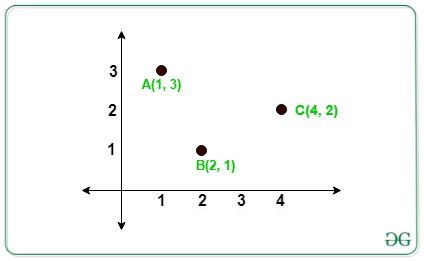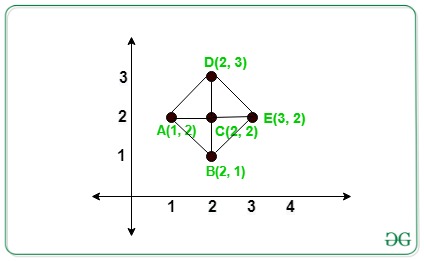给定二维平面上N个不同整数点的数组arr [] 。任务是从N个点开始计算直角三角形的数量,以使底角或垂线平行于X轴或Y轴。
例子:
Input: arr[][] = {{4, 2}, {2, 1}, {1, 3}}
Output: 0
Explanation:

In the above image there is no right-angled triangle formed.
Input: arr[][] = {{1, 2}, {2, 1}, {2, 2}, {2, 3}, {3, 2}}
Output: 4
Explanation:

In the above image there are 4 right-angled triangles formed by triangles ACB, ACD, DCE, BCE.
方法:想法是存储分别具有相同X和Y坐标的每个坐标的计数。现在遍历每个给定的点,并且由每个坐标(X,Y)形成的直角三角形的计数由下式给出:
Count of right-angled triangles = (frequencies of X coordinates – 1) * (frequencies of Y coordinates – 1)
步骤如下:
- 创建两个地图以存储点数,一个用于具有相同的X坐标,另一个用于具有相同的Y坐标。
- 对于x坐标图中和y坐标图中的每个值,请选择该对点作为枢轴元素,并找到该枢轴元素的频率。
- 对于上述步骤中的每个枢轴元素(例如ivot ),直角的计数由下式给出:
(m1[pivot].second-1)*(m2[pivot].second-1)
- 同样,为给定的其他N个点计算总的直角三角形。
- 最后,求和所有可能的三角形,将其作为最终答案。
下面是上述方法的实现:
C++
// C++ program for the above approach
#include
using namespace std;
// Function to find the number of right
// angled triangle that are formed from
// given N points whose perpendicular or
// base is parallel to X or Y axis
int RightAngled(int a[][2], int n)
{
// To store the number of points
// has same x or y coordinates
unordered_map xpoints;
unordered_map ypoints;
for (int i = 0; i < n; i++) {
xpoints[a[i][0]]++;
ypoints[a[i][1]]++;
}
// Store the total count of triangle
int count = 0;
// Iterate to check for total number
// of possible triangle
for (int i = 0; i < n; i++) {
if (xpoints[a[i][0]] >= 1
&& ypoints[a[i][1]] >= 1) {
// Add the count of triangles
// formed
count += (xpoints[a[i][0]] - 1)
* (ypoints[a[i][1]] - 1);
}
}
// Total possible triangle
return count;
}
// Driver Code
int main()
{
int N = 5;
// Given N points
int arr[][2] = { { 1, 2 }, { 2, 1 },
{ 2, 2 }, { 2, 3 },
{ 3, 2 } };
// Function Call
cout << RightAngled(arr, N);
return 0;
} Python3
# Python3 program for the above approach
from collections import defaultdict
# Function to find the number of right
# angled triangle that are formed from
# given N points whose perpendicular or
# base is parallel to X or Y axis
def RightAngled(a, n):
# To store the number of points
# has same x or y coordinates
xpoints = defaultdict(lambda:0)
ypoints = defaultdict(lambda:0)
for i in range(n):
xpoints[a[i][0]] += 1
ypoints[a[i][1]] += 1
# Store the total count of triangle
count = 0
# Iterate to check for total number
# of possible triangle
for i in range(n):
if (xpoints[a[i][0]] >= 1 and
ypoints[a[i][1]] >= 1):
# Add the count of triangles
# formed
count += ((xpoints[a[i][0]] - 1) *
(ypoints[a[i][1]] - 1))
# Total possible triangle
return count
# Driver Code
N = 5
# Given N points
arr = [ [ 1, 2 ], [ 2, 1 ],
[ 2, 2 ], [ 2, 3 ],
[ 3, 2 ] ]
# Function call
print(RightAngled(arr, N))
# This code is contributed by Stuti PathakJava
// Java program for the above approach
import java.util.*;
class GFG{
// Function to find the number of right
// angled triangle that are formed from
// given N points whose perpendicular or
// base is parallel to X or Y axis
static int RightAngled(int a[][], int n)
{
// To store the number of points
// has same x or y coordinates
HashMap xpoints = new HashMap();
HashMap ypoints = new HashMap();
for (int i = 0; i < n; i++)
{
if(xpoints.containsKey(a[i][0]))
{
xpoints.put(a[i][0], xpoints.get(a[i][0]) + 1);
}
else
{
xpoints.put(a[i][0], 1);
}
if(ypoints.containsKey(a[i][1]))
{
ypoints.put(a[i][1], ypoints.get(a[i][1]) + 1);
}
else
{
ypoints.put(a[i][1], 1);
}
}
// Store the total count of triangle
int count = 0;
// Iterate to check for total number
// of possible triangle
for (int i = 0; i < n; i++)
{
if (xpoints.get(a[i][0]) >= 1 &&
ypoints.get(a[i][1]) >= 1)
{
// Add the count of triangles
// formed
count += (xpoints.get(a[i][0]) - 1) *
(ypoints.get(a[i][1]) - 1);
}
}
// Total possible triangle
return count;
}
// Driver Code
public static void main(String[] args)
{
int N = 5;
// Given N points
int arr[][] = { { 1, 2 }, { 2, 1 },
{ 2, 2 }, { 2, 3 },
{ 3, 2 } };
// Function Call
System.out.print(RightAngled(arr, N));
}
}
// This code is contributed by Rajput-Ji C#
// C# program for the above approach
using System;
using System.Collections.Generic;
class GFG{
// Function to find the number of right
// angled triangle that are formed from
// given N points whose perpendicular or
// base is parallel to X or Y axis
static int RightAngled(int[, ] a, int n)
{
// To store the number of points
// has same x or y coordinates
Dictionary xpoints = new Dictionary();
Dictionary ypoints = new Dictionary();
for (int i = 0; i < n; i++)
{
if (xpoints.ContainsKey(a[i, 0]))
{
xpoints[a[i, 0]] = xpoints[a[i, 0]] + 1;
}
else
{
xpoints.Add(a[i, 0], 1);
}
if (ypoints.ContainsKey(a[i, 1]))
{
ypoints[a[i, 1]] = ypoints[a[i, 1]] + 1;
}
else
{
ypoints.Add(a[i, 1], 1);
}
}
// Store the total count of triangle
int count = 0;
// Iterate to check for total number
// of possible triangle
for (int i = 0; i < n; i++)
{
if (xpoints[a[i, 0]] >= 1 &&
ypoints[a[i, 1]] >= 1)
{
// Add the count of triangles
// formed
count += (xpoints[a[i, 0]] - 1) *
(ypoints[a[i, 1]] - 1);
}
}
// Total possible triangle
return count;
}
// Driver Code
public static void Main(String[] args)
{
int N = 5;
// Given N points
int[, ] arr = {{1, 2}, {2, 1},
{2, 2}, {2, 3}, {3, 2}};
// Function Call
Console.Write(RightAngled(arr, N));
}
}
// This code is contributed by Rajput-Ji 输出:
4时间复杂度: O(N)
辅助空间: O(1)